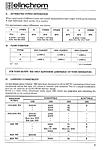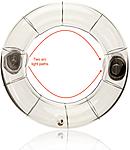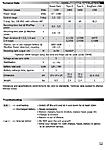Flash bulbs have a "burn-up" time or time required for ignition of the steel wool inside the oxygen filled glass envelop... typical "M" bulb takes about 20milliseconds to reach peak light output. This is also why vintage shutters have a "M" sync setting, to compensate for the time required for the flash bulb to reach peak light output, about 80milliseconds overall.
https://filmphotographyproject.com/flash-bulbs-lowdown/
Electronic strobe/flash units typically use a Xeon flash tube. They also have a time required to reach peak light output, except that time is often in micro seconds or less, far faster than a flash bulb (why "X" sync on shutters, and no image recorded if electronic flash/strobe is used with the shutter set at "M" sync) and their light output duration is typically shorter than a flash bulb. The xeon flash tube light output duration varies depending on tube design, power output, power source and..
One of the more common higher power flash tube configurations is circular (S type for Elinchrom) with ends like this

This flash tube has a single arc path producing light when triggered. Time required to reach peak light output and for the light form the arc to die off is related to the total length of the single arc path. If 4000watt/seconds of light output is produced by these single arc path flash tubes, the flash duration would be about 1/350 to 1/500 second. Not ideal for "stop" action images, trading off LOTs of light output.

Another type of flash tube has two arc light paths. This is achieved by placing the arc electrodes 180 degree apart in a circular tube (A type for Elinchrom).
With two paths for the arc to produce light, the effective distance between electrodes is reduced resulting in less time require for the arcs to produce peak light output and less time for the arcs to die out or dissipate.

If 4000watt/seconds of light output is produced by these single arc path flash tubes, the flash duration would be about 1/900 to 1/1000 second. Better for "stop action" images than the single arc light path flash tubes.
Then we get into lower power flash/strobe units that can produce shorter flash durations which is ideal for stop action images. Lowest power using an type A Elinchrom flash tube/head results in a flash duration of 1/4000 second, can work good for stop action images.

This flash duration spec has become a marketing hook in the current offering of electronic flash units. Note this flash duration for the Profoto 10 (near bottom of this page), it's flash duration grows as light output power grows. There is no escape from the physics involved with Xeon flash tubes.
http://www.peterbelanger.com/blog/20...1i1qswq0anj89h
At 2.4watt/seconds in their "freeze mode" flash duration is 1/80000 second which is not that different than compact portable flash/strobe units with similar light output. Once up to 2400watt/seconds flash duration is 1/1000 second in "freeze mode" which is much the same as using the A type flash tube/head for Elinchrom (at 4000watt/seconds, twice or 1 f-stop more than the Profoto 10). This is the current marketing game being played out in the current electronic flash/strobe struggle to sell their wares.
Current short duration electronic flash/strobe units achieve short flash duration by a combination of shorten arc light path tubes and a high power solid state device (IGBT, thyristor, SCR or similar) to cut off the power going into the flash tube. This with a combination of altering the regulated voltage at the flash capacitors and time allowed of energy flow into the flash tube is how modern electronic flash units achieve 7 or more f-stops of light output range gaining the ability to reduce flash duration time.
Bernice




 Reply With Quote
Reply With Quote


Bookmarks